Comprehensive Tender Estimation Report for Construction Projects
VerifiedAdded on 2022/03/28
|28
|4797
|171
Report
AI Summary
This report, prepared for a Tender Estimate assignment in the 3rd semester, offers a comprehensive study of estimation within the construction industry. It focuses on the critical aspects of tender estimation, including the process of pricing, factors influencing pricing decisions, the sources and nature of required information, and the calculation of all-in rates for labor, construction plants, and materials. The report explores the steps involved in the tender pricing process, various contract types, and the factors to consider when pricing a tender. It also identifies essential information sources for cost estimating, such as human resource plans, project schedules, scope baselines, and enterprise environmental factors. Furthermore, the report provides detailed calculations for all-in rates for skilled labor, bricks, ceramic tiles, and excavators, including considerations for labor costs, material costs, and plant operational expenses. Finally, the report also touches upon the factors that need to be considered in building up unit rates for bill items. This report serves as a valuable resource for students studying quantity surveying and construction management, offering practical insights into the complexities of tender estimation and cost control.
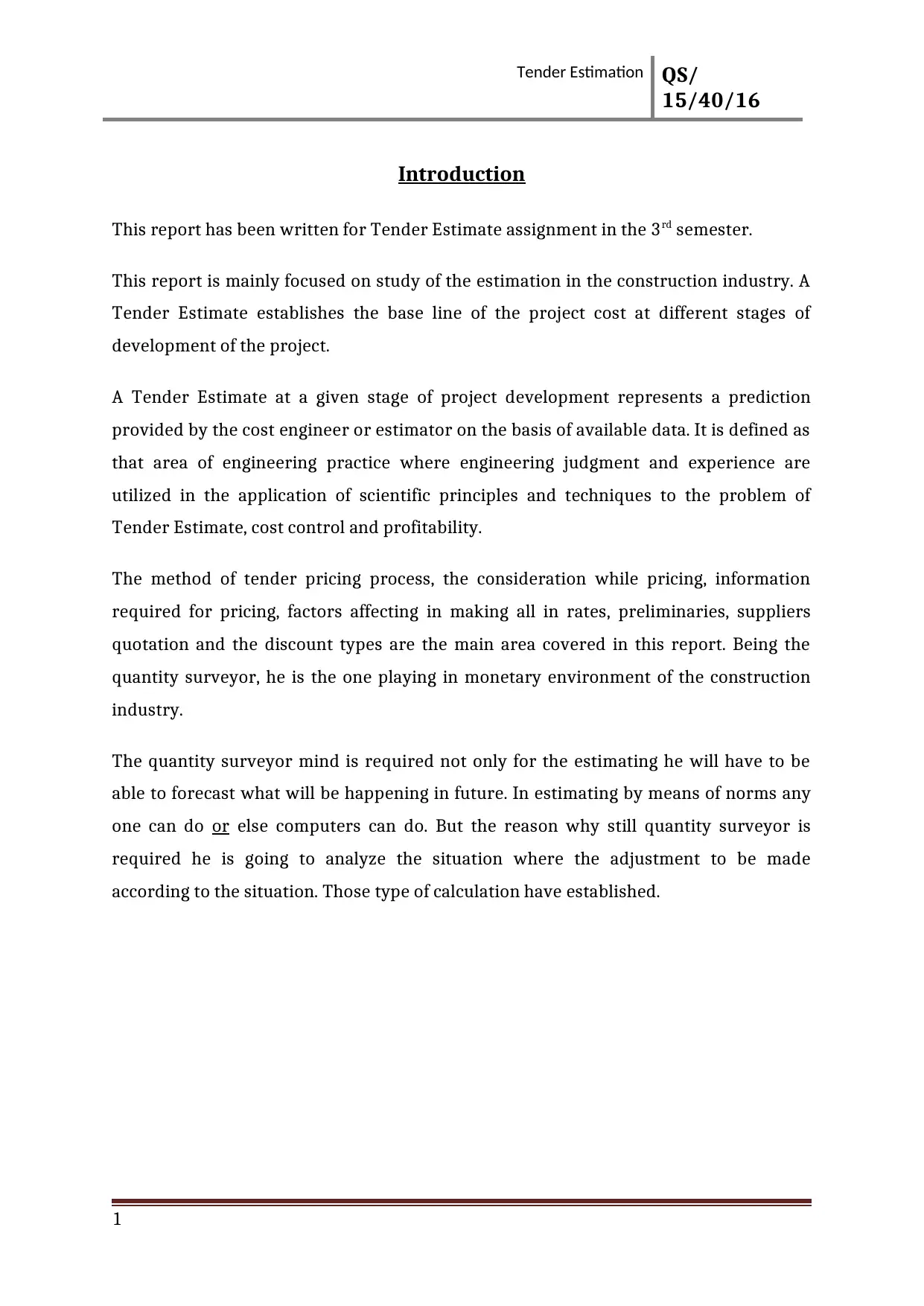
Tender Estimation QS/
15/40/16
Introduction
This report has been written for Tender Estimate assignment in the 3rd semester.
This report is mainly focused on study of the estimation in the construction industry. A
Tender Estimate establishes the base line of the project cost at different stages of
development of the project.
A Tender Estimate at a given stage of project development represents a prediction
provided by the cost engineer or estimator on the basis of available data. It is defined as
that area of engineering practice where engineering judgment and experience are
utilized in the application of scientific principles and techniques to the problem of
Tender Estimate, cost control and profitability.
The method of tender pricing process, the consideration while pricing, information
required for pricing, factors affecting in making all in rates, preliminaries, suppliers
quotation and the discount types are the main area covered in this report. Being the
quantity surveyor, he is the one playing in monetary environment of the construction
industry.
The quantity surveyor mind is required not only for the estimating he will have to be
able to forecast what will be happening in future. In estimating by means of norms any
one can do or else computers can do. But the reason why still quantity surveyor is
required he is going to analyze the situation where the adjustment to be made
according to the situation. Those type of calculation have established.
1
15/40/16
Introduction
This report has been written for Tender Estimate assignment in the 3rd semester.
This report is mainly focused on study of the estimation in the construction industry. A
Tender Estimate establishes the base line of the project cost at different stages of
development of the project.
A Tender Estimate at a given stage of project development represents a prediction
provided by the cost engineer or estimator on the basis of available data. It is defined as
that area of engineering practice where engineering judgment and experience are
utilized in the application of scientific principles and techniques to the problem of
Tender Estimate, cost control and profitability.
The method of tender pricing process, the consideration while pricing, information
required for pricing, factors affecting in making all in rates, preliminaries, suppliers
quotation and the discount types are the main area covered in this report. Being the
quantity surveyor, he is the one playing in monetary environment of the construction
industry.
The quantity surveyor mind is required not only for the estimating he will have to be
able to forecast what will be happening in future. In estimating by means of norms any
one can do or else computers can do. But the reason why still quantity surveyor is
required he is going to analyze the situation where the adjustment to be made
according to the situation. Those type of calculation have established.
1
Paraphrase This Document
Need a fresh take? Get an instant paraphrase of this document with our AI Paraphraser
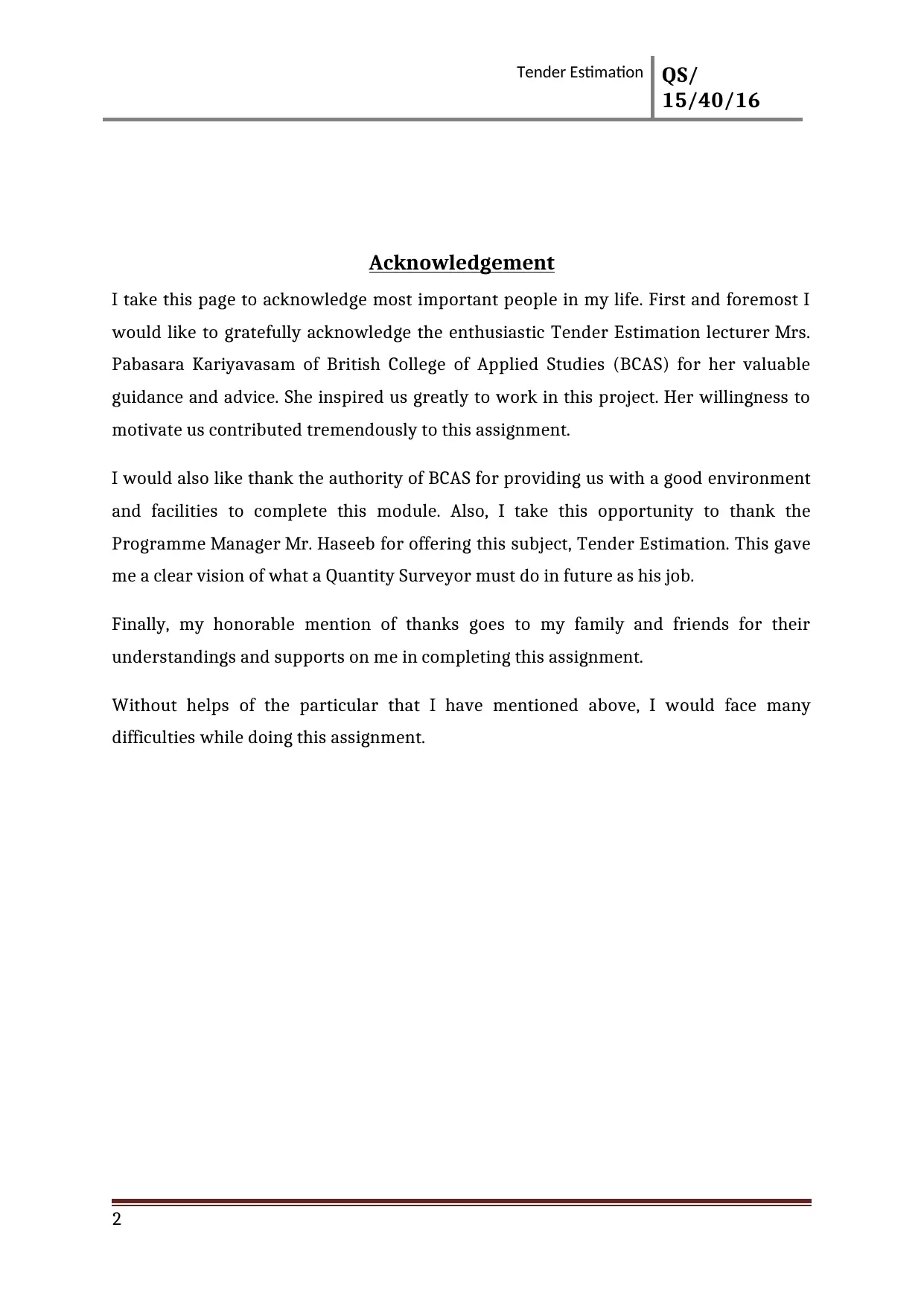
Tender Estimation QS/
15/40/16
Acknowledgement
I take this page to acknowledge most important people in my life. First and foremost I
would like to gratefully acknowledge the enthusiastic Tender Estimation lecturer Mrs.
Pabasara Kariyavasam of British College of Applied Studies (BCAS) for her valuable
guidance and advice. She inspired us greatly to work in this project. Her willingness to
motivate us contributed tremendously to this assignment.
I would also like thank the authority of BCAS for providing us with a good environment
and facilities to complete this module. Also, I take this opportunity to thank the
Programme Manager Mr. Haseeb for offering this subject, Tender Estimation. This gave
me a clear vision of what a Quantity Surveyor must do in future as his job.
Finally, my honorable mention of thanks goes to my family and friends for their
understandings and supports on me in completing this assignment.
Without helps of the particular that I have mentioned above, I would face many
difficulties while doing this assignment.
2
15/40/16
Acknowledgement
I take this page to acknowledge most important people in my life. First and foremost I
would like to gratefully acknowledge the enthusiastic Tender Estimation lecturer Mrs.
Pabasara Kariyavasam of British College of Applied Studies (BCAS) for her valuable
guidance and advice. She inspired us greatly to work in this project. Her willingness to
motivate us contributed tremendously to this assignment.
I would also like thank the authority of BCAS for providing us with a good environment
and facilities to complete this module. Also, I take this opportunity to thank the
Programme Manager Mr. Haseeb for offering this subject, Tender Estimation. This gave
me a clear vision of what a Quantity Surveyor must do in future as his job.
Finally, my honorable mention of thanks goes to my family and friends for their
understandings and supports on me in completing this assignment.
Without helps of the particular that I have mentioned above, I would face many
difficulties while doing this assignment.
2
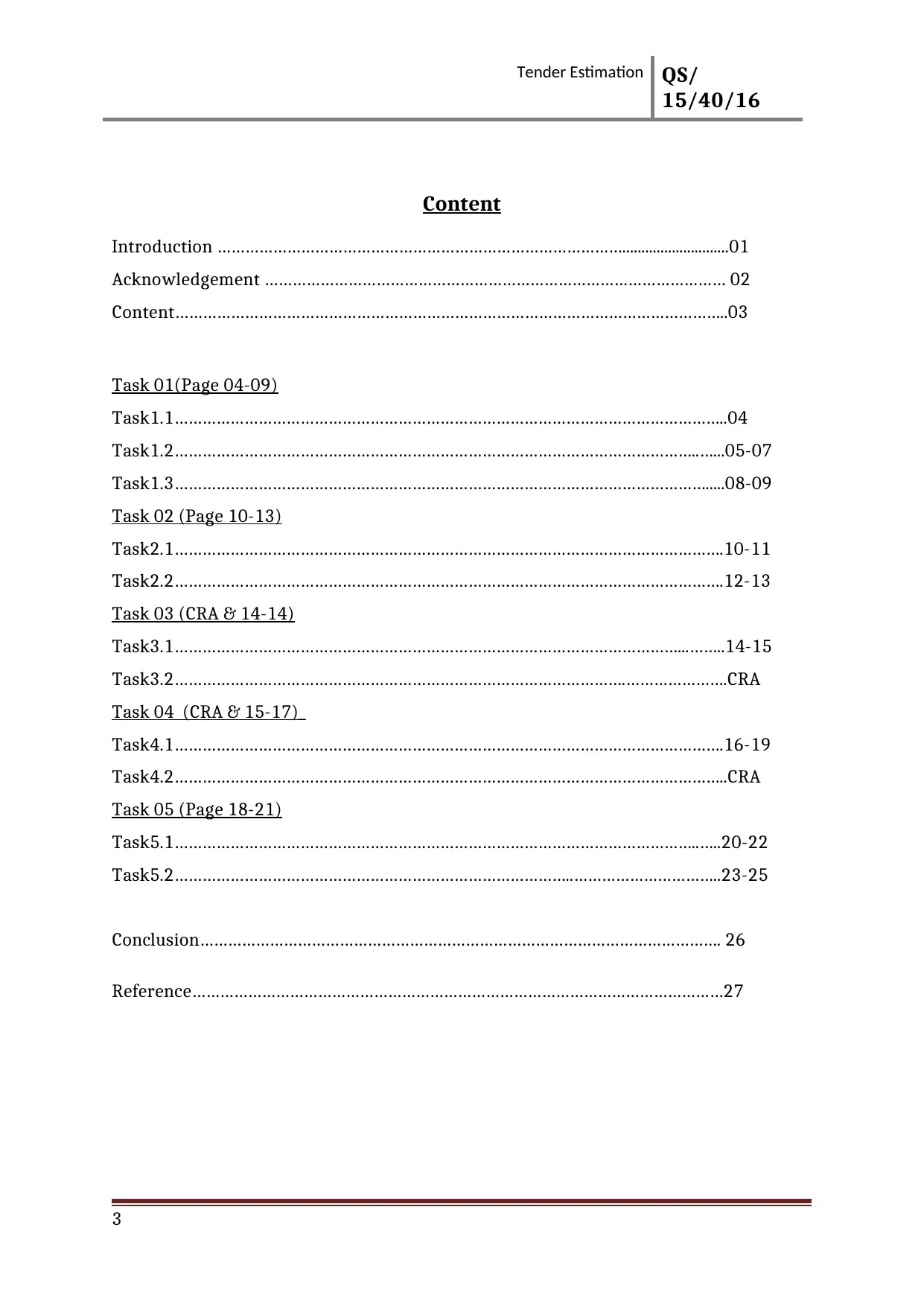
Tender Estimation QS/
15/40/16
Content
Introduction ……………………………………………………………………………............................01
Acknowledgement ……………………………………………………………………………………… 02
Content………………………………………………………………………………………………………..03
Task 01(Page 04-09)
Task1.1………………………………………………………………………………………………………..04
Task1.2…………………………………………………………………………………………………..…...05-07
Task1.3…………………………………………………………………………………………………….....08-09
Task 02 (Page 10-13)
Task2.1……………………………………………………………………………………………………….10-11
Task2.2……………………………………………………………………………………………………….12-13
Task 03 (CRA & 14-14)
Task3.1………………………………………………………………………………………………...……..14-15
Task3.2…………………………………………………………………………………….………………….CRA
Task 04 (CRA & 15-17)_
Task4.1……………………………………………………………………………………………………….16-19
Task4.2………………………………………………………………………………………………………..CRA
Task 05 (Page 18-21)
Task5.1…………………………………………………………………………………………………..…..20-22
Task5.2…………………………………………………………………………..…………………………..23-25
Conclusion…………………………………………………………………………………………………. 26
Reference……………………………………………………………………………………………………27
3
15/40/16
Content
Introduction ……………………………………………………………………………............................01
Acknowledgement ……………………………………………………………………………………… 02
Content………………………………………………………………………………………………………..03
Task 01(Page 04-09)
Task1.1………………………………………………………………………………………………………..04
Task1.2…………………………………………………………………………………………………..…...05-07
Task1.3…………………………………………………………………………………………………….....08-09
Task 02 (Page 10-13)
Task2.1……………………………………………………………………………………………………….10-11
Task2.2……………………………………………………………………………………………………….12-13
Task 03 (CRA & 14-14)
Task3.1………………………………………………………………………………………………...……..14-15
Task3.2…………………………………………………………………………………….………………….CRA
Task 04 (CRA & 15-17)_
Task4.1……………………………………………………………………………………………………….16-19
Task4.2………………………………………………………………………………………………………..CRA
Task 05 (Page 18-21)
Task5.1…………………………………………………………………………………………………..…..20-22
Task5.2…………………………………………………………………………..…………………………..23-25
Conclusion…………………………………………………………………………………………………. 26
Reference……………………………………………………………………………………………………27
3
⊘ This is a preview!⊘
Do you want full access?
Subscribe today to unlock all pages.

Trusted by 1+ million students worldwide
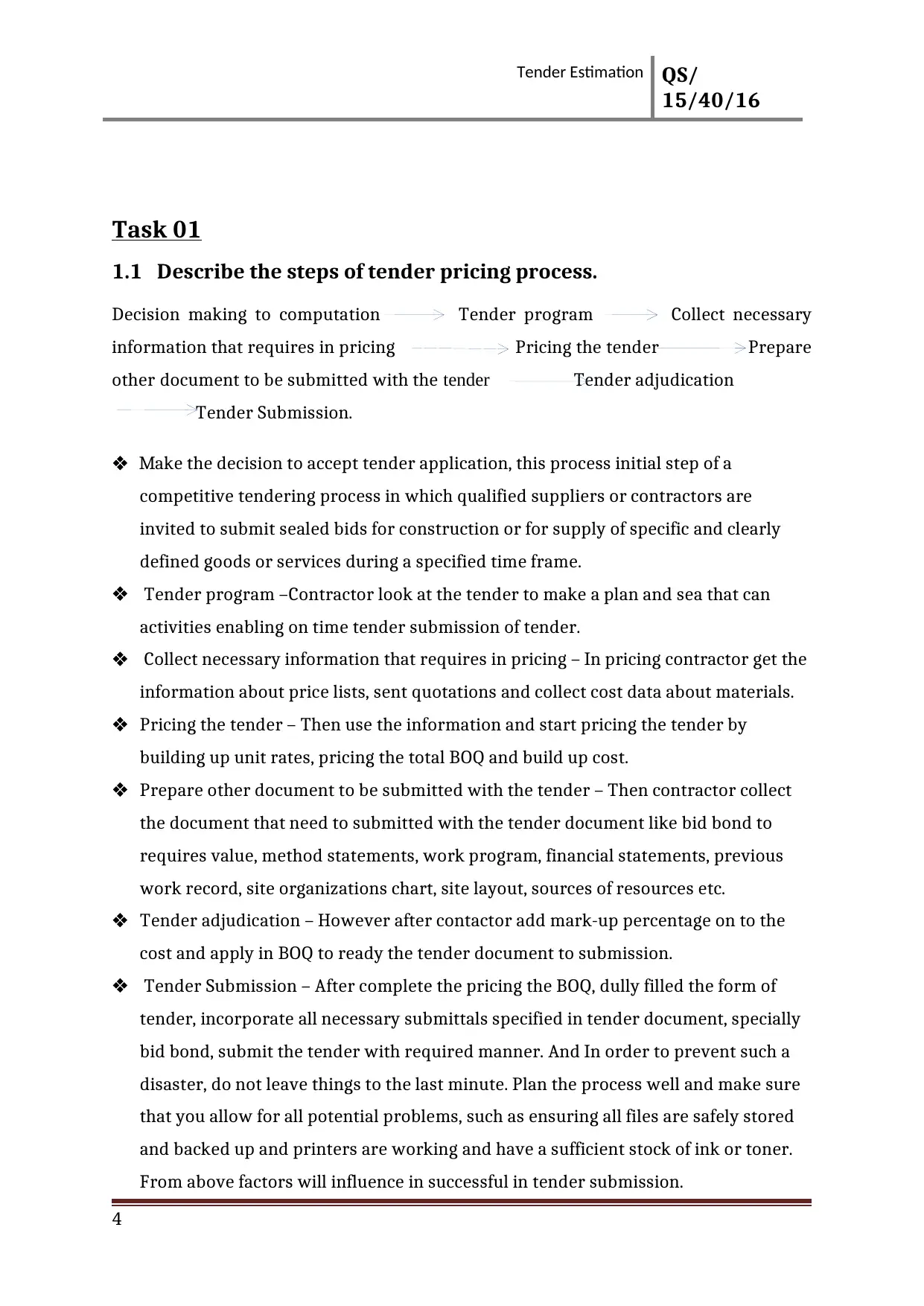
Tender Estimation QS/
15/40/16
Task 01
1.1 Describe the steps of tender pricing process.
Decision making to computation Tender program Collect necessary
information that requires in pricing Pricing the tender Prepare
other document to be submitted with the tender Tender adjudication
Tender Submission.
Make the decision to accept tender application, this process initial step of a
competitive tendering process in which qualified suppliers or contractors are
invited to submit sealed bids for construction or for supply of specific and clearly
defined goods or services during a specified time frame.
Tender program –Contractor look at the tender to make a plan and sea that can
activities enabling on time tender submission of tender.
Collect necessary information that requires in pricing – In pricing contractor get the
information about price lists, sent quotations and collect cost data about materials.
Pricing the tender – Then use the information and start pricing the tender by
building up unit rates, pricing the total BOQ and build up cost.
Prepare other document to be submitted with the tender – Then contractor collect
the document that need to submitted with the tender document like bid bond to
requires value, method statements, work program, financial statements, previous
work record, site organizations chart, site layout, sources of resources etc.
Tender adjudication – However after contactor add mark-up percentage on to the
cost and apply in BOQ to ready the tender document to submission.
Tender Submission – After complete the pricing the BOQ, dully filled the form of
tender, incorporate all necessary submittals specified in tender document, specially
bid bond, submit the tender with required manner. And In order to prevent such a
disaster, do not leave things to the last minute. Plan the process well and make sure
that you allow for all potential problems, such as ensuring all files are safely stored
and backed up and printers are working and have a sufficient stock of ink or toner.
From above factors will influence in successful in tender submission.
4
15/40/16
Task 01
1.1 Describe the steps of tender pricing process.
Decision making to computation Tender program Collect necessary
information that requires in pricing Pricing the tender Prepare
other document to be submitted with the tender Tender adjudication
Tender Submission.
Make the decision to accept tender application, this process initial step of a
competitive tendering process in which qualified suppliers or contractors are
invited to submit sealed bids for construction or for supply of specific and clearly
defined goods or services during a specified time frame.
Tender program –Contractor look at the tender to make a plan and sea that can
activities enabling on time tender submission of tender.
Collect necessary information that requires in pricing – In pricing contractor get the
information about price lists, sent quotations and collect cost data about materials.
Pricing the tender – Then use the information and start pricing the tender by
building up unit rates, pricing the total BOQ and build up cost.
Prepare other document to be submitted with the tender – Then contractor collect
the document that need to submitted with the tender document like bid bond to
requires value, method statements, work program, financial statements, previous
work record, site organizations chart, site layout, sources of resources etc.
Tender adjudication – However after contactor add mark-up percentage on to the
cost and apply in BOQ to ready the tender document to submission.
Tender Submission – After complete the pricing the BOQ, dully filled the form of
tender, incorporate all necessary submittals specified in tender document, specially
bid bond, submit the tender with required manner. And In order to prevent such a
disaster, do not leave things to the last minute. Plan the process well and make sure
that you allow for all potential problems, such as ensuring all files are safely stored
and backed up and printers are working and have a sufficient stock of ink or toner.
From above factors will influence in successful in tender submission.
4
Paraphrase This Document
Need a fresh take? Get an instant paraphrase of this document with our AI Paraphraser
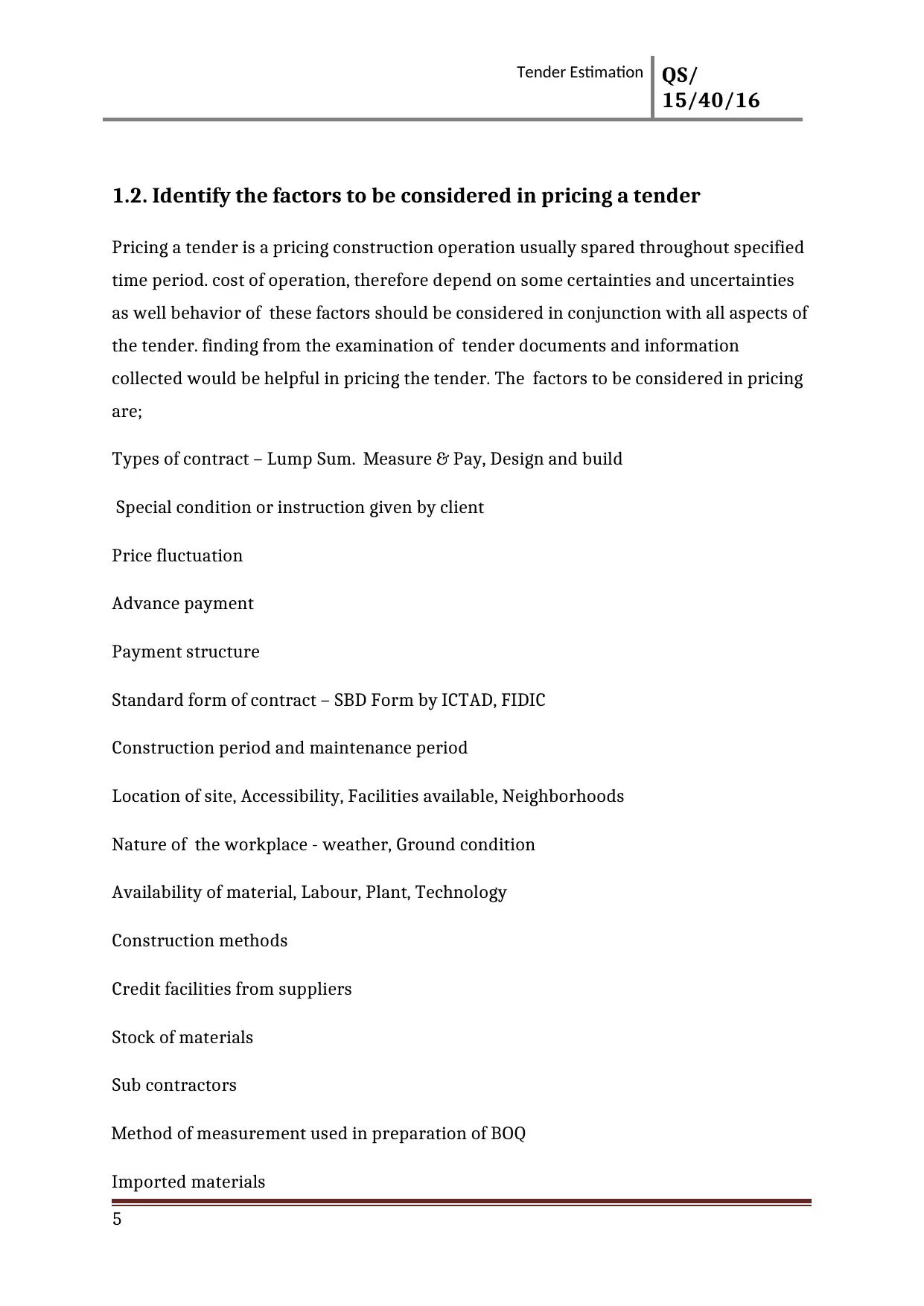
Tender Estimation QS/
15/40/16
1.2. Identify the factors to be considered in pricing a tender
Pricing a tender is a pricing construction operation usually spared throughout specified
time period. cost of operation, therefore depend on some certainties and uncertainties
as well behavior of these factors should be considered in conjunction with all aspects of
the tender. finding from the examination of tender documents and information
collected would be helpful in pricing the tender. The factors to be considered in pricing
are;
Types of contract – Lump Sum. Measure & Pay, Design and build
Special condition or instruction given by client
Price fluctuation
Advance payment
Payment structure
Standard form of contract – SBD Form by ICTAD, FIDIC
Construction period and maintenance period
Location of site, Accessibility, Facilities available, Neighborhoods
Nature of the workplace - weather, Ground condition
Availability of material, Labour, Plant, Technology
Construction methods
Credit facilities from suppliers
Stock of materials
Sub contractors
Method of measurement used in preparation of BOQ
Imported materials
5
15/40/16
1.2. Identify the factors to be considered in pricing a tender
Pricing a tender is a pricing construction operation usually spared throughout specified
time period. cost of operation, therefore depend on some certainties and uncertainties
as well behavior of these factors should be considered in conjunction with all aspects of
the tender. finding from the examination of tender documents and information
collected would be helpful in pricing the tender. The factors to be considered in pricing
are;
Types of contract – Lump Sum. Measure & Pay, Design and build
Special condition or instruction given by client
Price fluctuation
Advance payment
Payment structure
Standard form of contract – SBD Form by ICTAD, FIDIC
Construction period and maintenance period
Location of site, Accessibility, Facilities available, Neighborhoods
Nature of the workplace - weather, Ground condition
Availability of material, Labour, Plant, Technology
Construction methods
Credit facilities from suppliers
Stock of materials
Sub contractors
Method of measurement used in preparation of BOQ
Imported materials
5
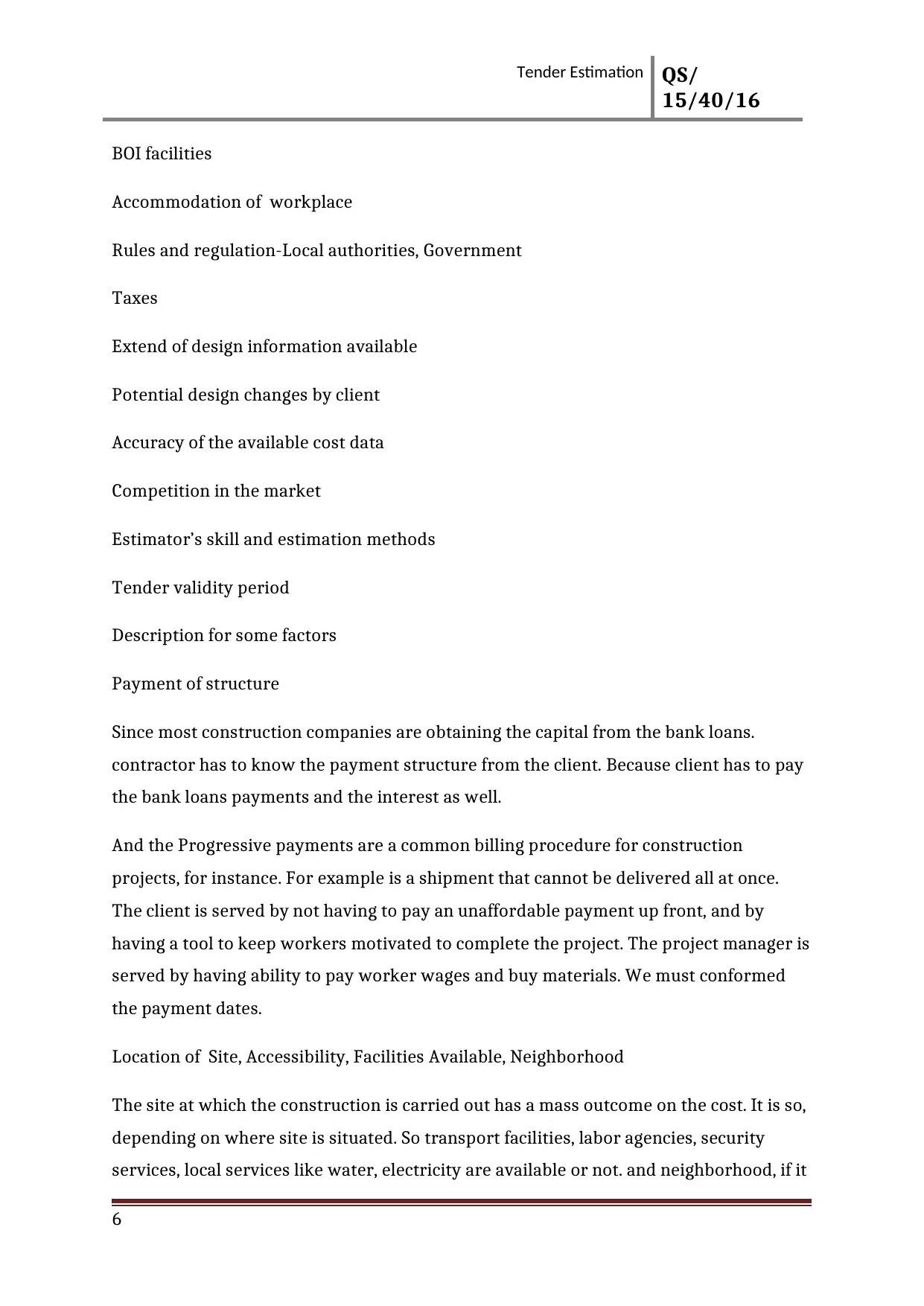
Tender Estimation QS/
15/40/16
BOI facilities
Accommodation of workplace
Rules and regulation-Local authorities, Government
Taxes
Extend of design information available
Potential design changes by client
Accuracy of the available cost data
Competition in the market
Estimator’s skill and estimation methods
Tender validity period
Description for some factors
Payment of structure
Since most construction companies are obtaining the capital from the bank loans.
contractor has to know the payment structure from the client. Because client has to pay
the bank loans payments and the interest as well.
And the Progressive payments are a common billing procedure for construction
projects, for instance. For example is a shipment that cannot be delivered all at once.
The client is served by not having to pay an unaffordable payment up front, and by
having a tool to keep workers motivated to complete the project. The project manager is
served by having ability to pay worker wages and buy materials. We must conformed
the payment dates.
Location of Site, Accessibility, Facilities Available, Neighborhood
The site at which the construction is carried out has a mass outcome on the cost. It is so,
depending on where site is situated. So transport facilities, labor agencies, security
services, local services like water, electricity are available or not. and neighborhood, if it
6
15/40/16
BOI facilities
Accommodation of workplace
Rules and regulation-Local authorities, Government
Taxes
Extend of design information available
Potential design changes by client
Accuracy of the available cost data
Competition in the market
Estimator’s skill and estimation methods
Tender validity period
Description for some factors
Payment of structure
Since most construction companies are obtaining the capital from the bank loans.
contractor has to know the payment structure from the client. Because client has to pay
the bank loans payments and the interest as well.
And the Progressive payments are a common billing procedure for construction
projects, for instance. For example is a shipment that cannot be delivered all at once.
The client is served by not having to pay an unaffordable payment up front, and by
having a tool to keep workers motivated to complete the project. The project manager is
served by having ability to pay worker wages and buy materials. We must conformed
the payment dates.
Location of Site, Accessibility, Facilities Available, Neighborhood
The site at which the construction is carried out has a mass outcome on the cost. It is so,
depending on where site is situated. So transport facilities, labor agencies, security
services, local services like water, electricity are available or not. and neighborhood, if it
6
⊘ This is a preview!⊘
Do you want full access?
Subscribe today to unlock all pages.

Trusted by 1+ million students worldwide
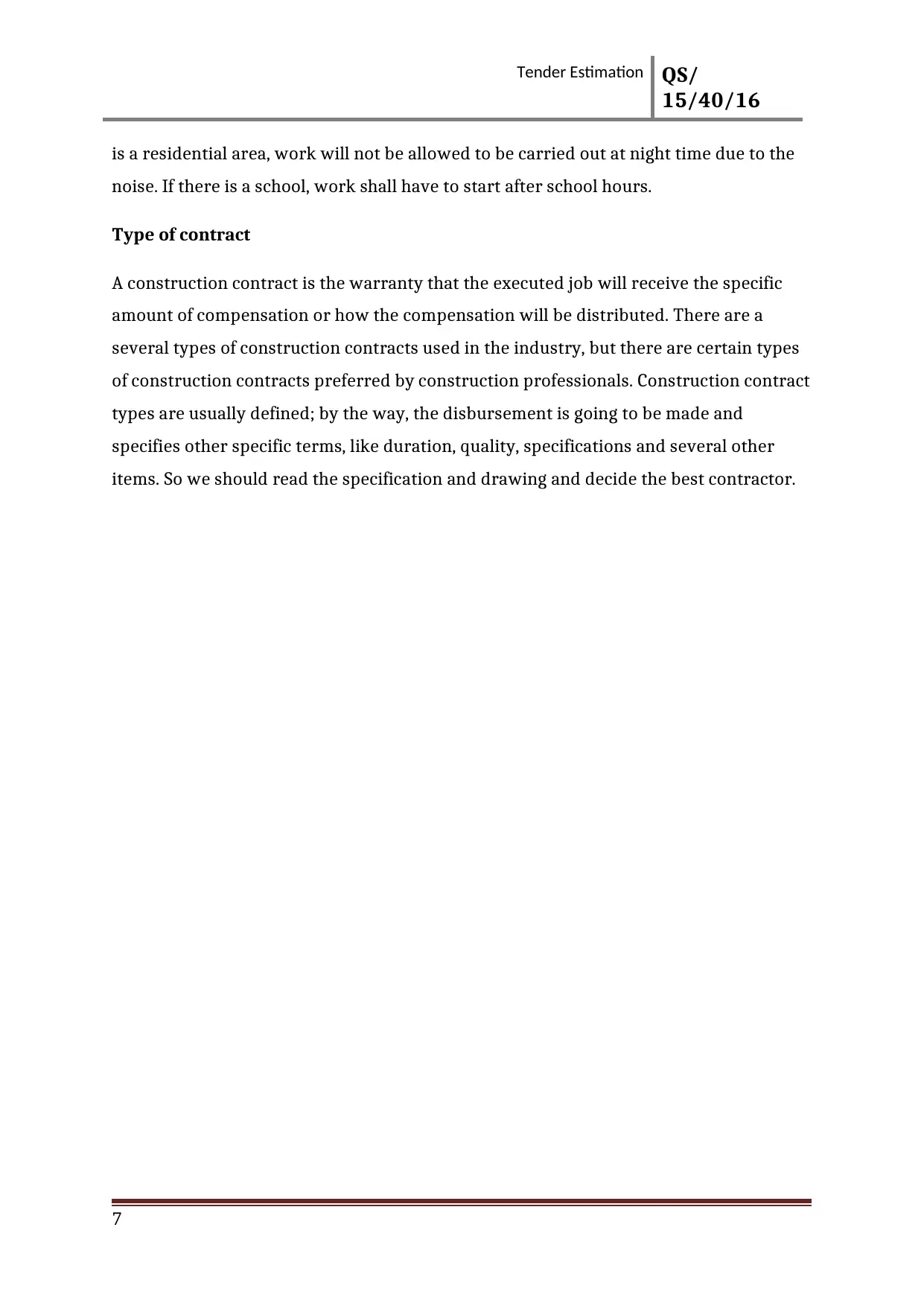
Tender Estimation QS/
15/40/16
is a residential area, work will not be allowed to be carried out at night time due to the
noise. If there is a school, work shall have to start after school hours.
Type of contract
A construction contract is the warranty that the executed job will receive the specific
amount of compensation or how the compensation will be distributed. There are a
several types of construction contracts used in the industry, but there are certain types
of construction contracts preferred by construction professionals. Construction contract
types are usually defined; by the way, the disbursement is going to be made and
specifies other specific terms, like duration, quality, specifications and several other
items. So we should read the specification and drawing and decide the best contractor.
7
15/40/16
is a residential area, work will not be allowed to be carried out at night time due to the
noise. If there is a school, work shall have to start after school hours.
Type of contract
A construction contract is the warranty that the executed job will receive the specific
amount of compensation or how the compensation will be distributed. There are a
several types of construction contracts used in the industry, but there are certain types
of construction contracts preferred by construction professionals. Construction contract
types are usually defined; by the way, the disbursement is going to be made and
specifies other specific terms, like duration, quality, specifications and several other
items. So we should read the specification and drawing and decide the best contractor.
7
Paraphrase This Document
Need a fresh take? Get an instant paraphrase of this document with our AI Paraphraser
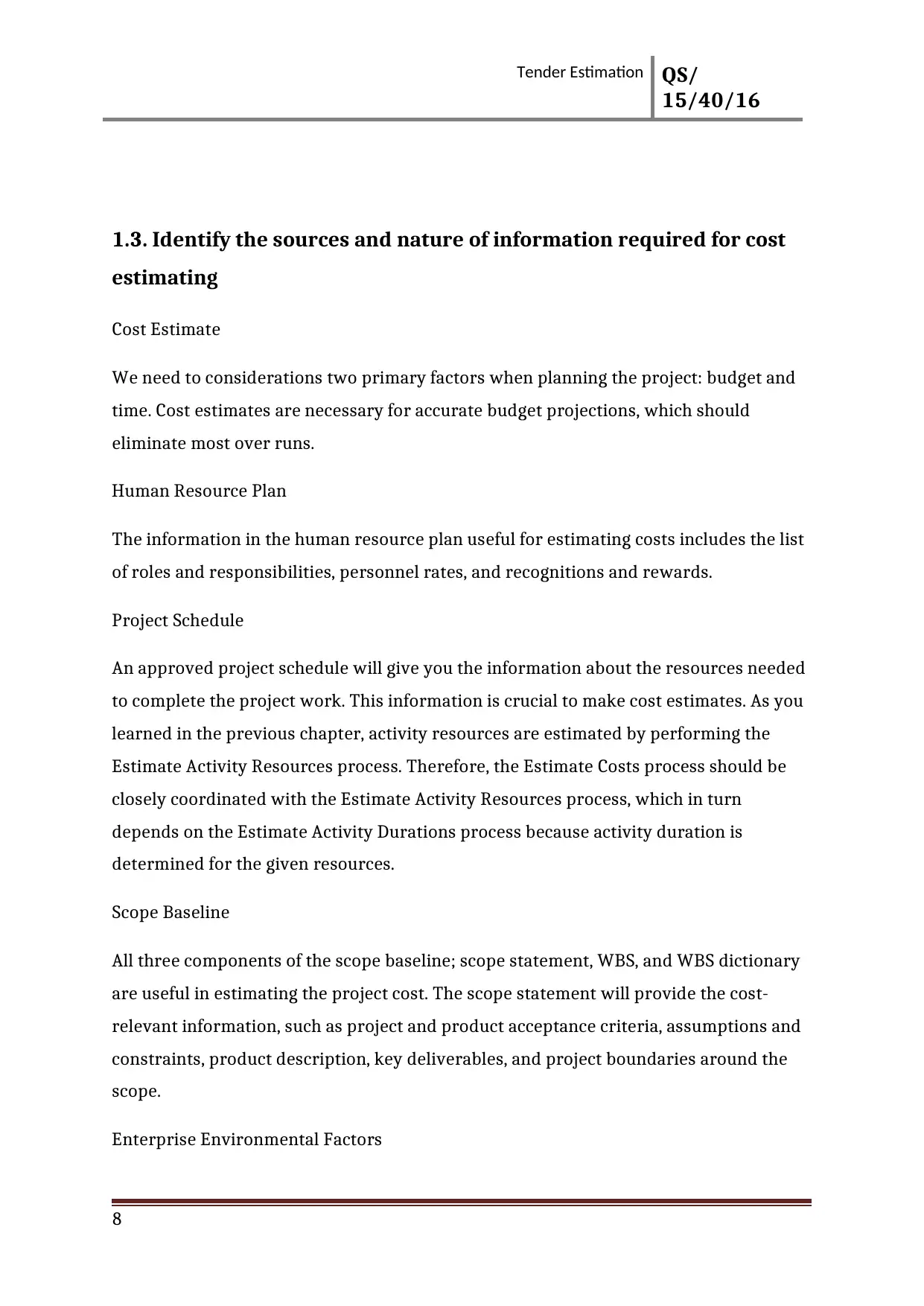
Tender Estimation QS/
15/40/16
1.3. Identify the sources and nature of information required for cost
estimating
Cost Estimate
We need to considerations two primary factors when planning the project: budget and
time. Cost estimates are necessary for accurate budget projections, which should
eliminate most over runs.
Human Resource Plan
The information in the human resource plan useful for estimating costs includes the list
of roles and responsibilities, personnel rates, and recognitions and rewards.
Project Schedule
An approved project schedule will give you the information about the resources needed
to complete the project work. This information is crucial to make cost estimates. As you
learned in the previous chapter, activity resources are estimated by performing the
Estimate Activity Resources process. Therefore, the Estimate Costs process should be
closely coordinated with the Estimate Activity Resources process, which in turn
depends on the Estimate Activity Durations process because activity duration is
determined for the given resources.
Scope Baseline
All three components of the scope baseline; scope statement, WBS, and WBS dictionary
are useful in estimating the project cost. The scope statement will provide the cost-
relevant information, such as project and product acceptance criteria, assumptions and
constraints, product description, key deliverables, and project boundaries around the
scope.
Enterprise Environmental Factors
8
15/40/16
1.3. Identify the sources and nature of information required for cost
estimating
Cost Estimate
We need to considerations two primary factors when planning the project: budget and
time. Cost estimates are necessary for accurate budget projections, which should
eliminate most over runs.
Human Resource Plan
The information in the human resource plan useful for estimating costs includes the list
of roles and responsibilities, personnel rates, and recognitions and rewards.
Project Schedule
An approved project schedule will give you the information about the resources needed
to complete the project work. This information is crucial to make cost estimates. As you
learned in the previous chapter, activity resources are estimated by performing the
Estimate Activity Resources process. Therefore, the Estimate Costs process should be
closely coordinated with the Estimate Activity Resources process, which in turn
depends on the Estimate Activity Durations process because activity duration is
determined for the given resources.
Scope Baseline
All three components of the scope baseline; scope statement, WBS, and WBS dictionary
are useful in estimating the project cost. The scope statement will provide the cost-
relevant information, such as project and product acceptance criteria, assumptions and
constraints, product description, key deliverables, and project boundaries around the
scope.
Enterprise Environmental Factors
8
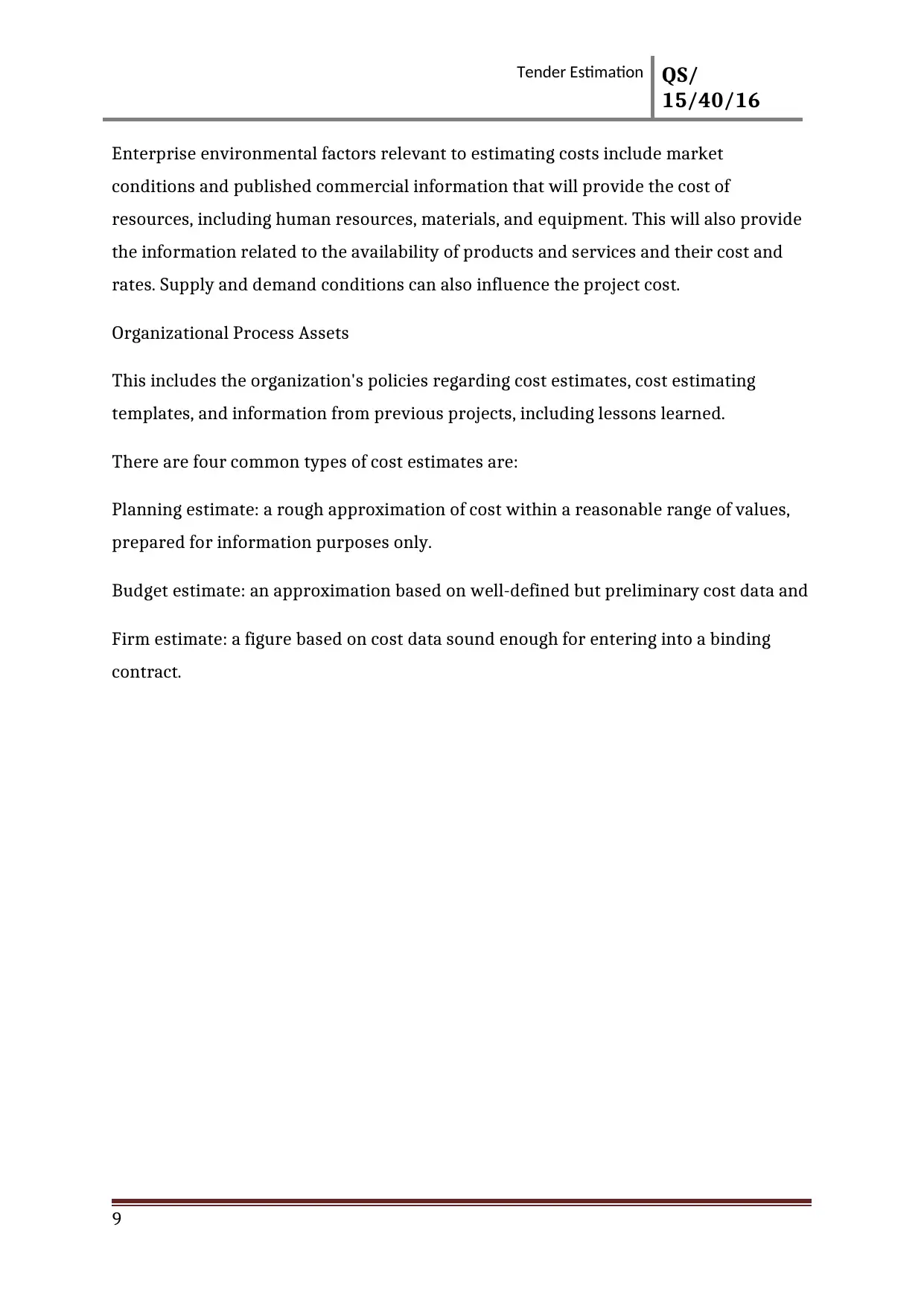
Tender Estimation QS/
15/40/16
Enterprise environmental factors relevant to estimating costs include market
conditions and published commercial information that will provide the cost of
resources, including human resources, materials, and equipment. This will also provide
the information related to the availability of products and services and their cost and
rates. Supply and demand conditions can also influence the project cost.
Organizational Process Assets
This includes the organization's policies regarding cost estimates, cost estimating
templates, and information from previous projects, including lessons learned.
There are four common types of cost estimates are:
Planning estimate: a rough approximation of cost within a reasonable range of values,
prepared for information purposes only.
Budget estimate: an approximation based on well-defined but preliminary cost data and
Firm estimate: a figure based on cost data sound enough for entering into a binding
contract.
9
15/40/16
Enterprise environmental factors relevant to estimating costs include market
conditions and published commercial information that will provide the cost of
resources, including human resources, materials, and equipment. This will also provide
the information related to the availability of products and services and their cost and
rates. Supply and demand conditions can also influence the project cost.
Organizational Process Assets
This includes the organization's policies regarding cost estimates, cost estimating
templates, and information from previous projects, including lessons learned.
There are four common types of cost estimates are:
Planning estimate: a rough approximation of cost within a reasonable range of values,
prepared for information purposes only.
Budget estimate: an approximation based on well-defined but preliminary cost data and
Firm estimate: a figure based on cost data sound enough for entering into a binding
contract.
9
⊘ This is a preview!⊘
Do you want full access?
Subscribe today to unlock all pages.

Trusted by 1+ million students worldwide
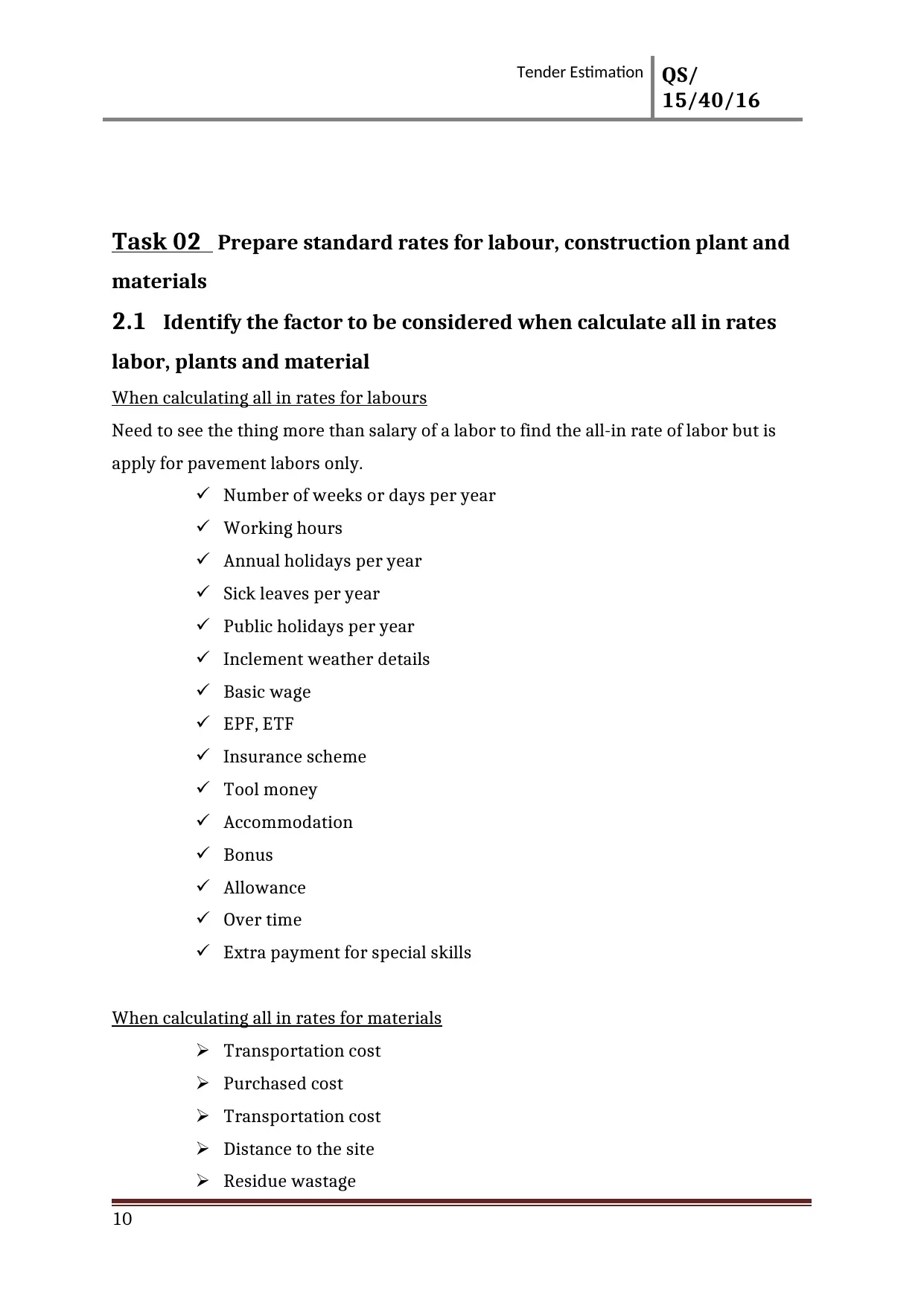
Tender Estimation QS/
15/40/16
Task 02 Prepare standard rates for labour, construction plant and
materials
2.1 Identify the factor to be considered when calculate all in rates
labor, plants and material
When calculating all in rates for labours
Need to see the thing more than salary of a labor to find the all-in rate of labor but is
apply for pavement labors only.
Number of weeks or days per year
Working hours
Annual holidays per year
Sick leaves per year
Public holidays per year
Inclement weather details
Basic wage
EPF, ETF
Insurance scheme
Tool money
Accommodation
Bonus
Allowance
Over time
Extra payment for special skills
When calculating all in rates for materials
Transportation cost
Purchased cost
Transportation cost
Distance to the site
Residue wastage
10
15/40/16
Task 02 Prepare standard rates for labour, construction plant and
materials
2.1 Identify the factor to be considered when calculate all in rates
labor, plants and material
When calculating all in rates for labours
Need to see the thing more than salary of a labor to find the all-in rate of labor but is
apply for pavement labors only.
Number of weeks or days per year
Working hours
Annual holidays per year
Sick leaves per year
Public holidays per year
Inclement weather details
Basic wage
EPF, ETF
Insurance scheme
Tool money
Accommodation
Bonus
Allowance
Over time
Extra payment for special skills
When calculating all in rates for materials
Transportation cost
Purchased cost
Transportation cost
Distance to the site
Residue wastage
10
Paraphrase This Document
Need a fresh take? Get an instant paraphrase of this document with our AI Paraphraser
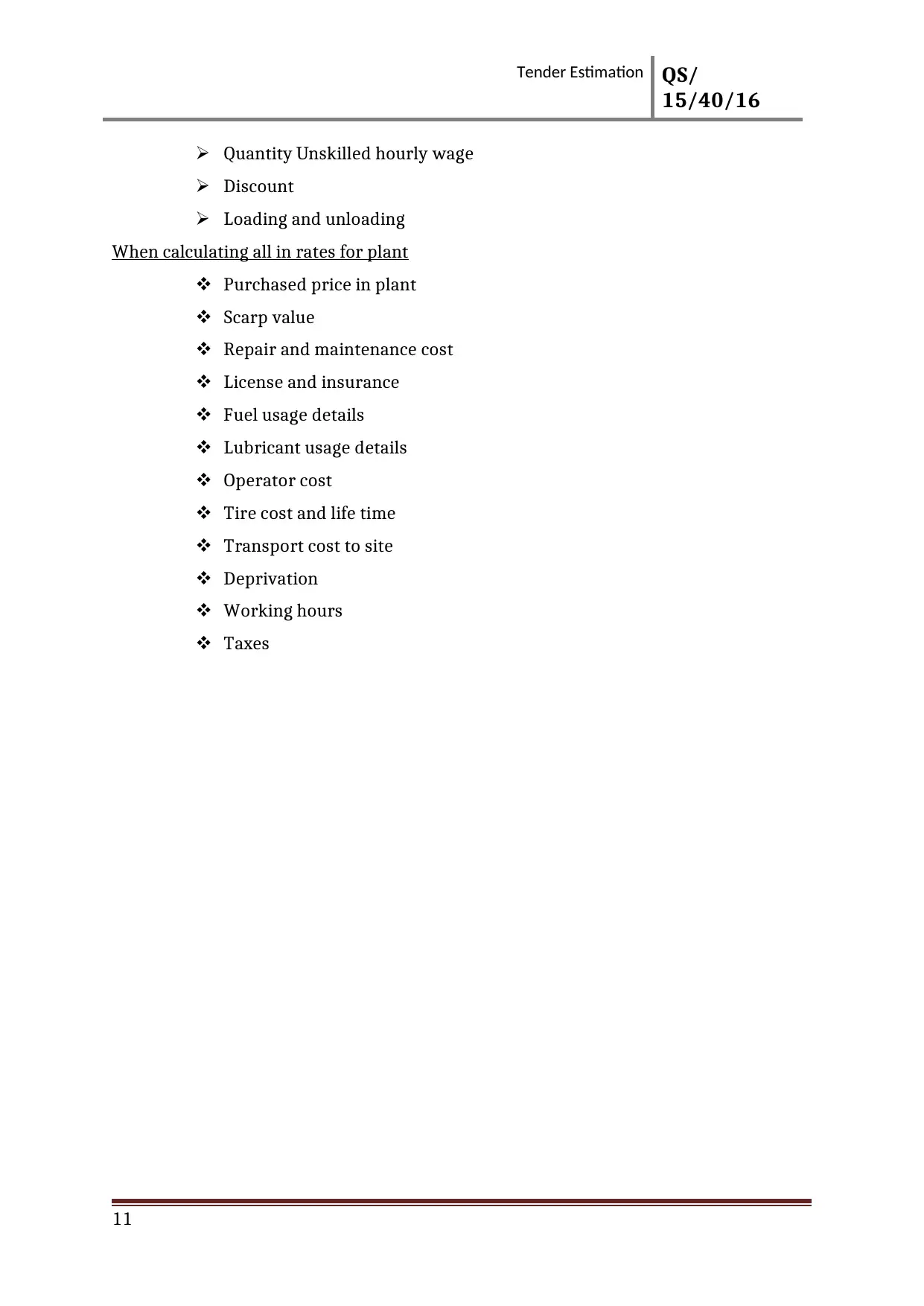
Tender Estimation QS/
15/40/16
Quantity Unskilled hourly wage
Discount
Loading and unloading
When calculating all in rates for plant
Purchased price in plant
Scarp value
Repair and maintenance cost
License and insurance
Fuel usage details
Lubricant usage details
Operator cost
Tire cost and life time
Transport cost to site
Deprivation
Working hours
Taxes
11
15/40/16
Quantity Unskilled hourly wage
Discount
Loading and unloading
When calculating all in rates for plant
Purchased price in plant
Scarp value
Repair and maintenance cost
License and insurance
Fuel usage details
Lubricant usage details
Operator cost
Tire cost and life time
Transport cost to site
Deprivation
Working hours
Taxes
11
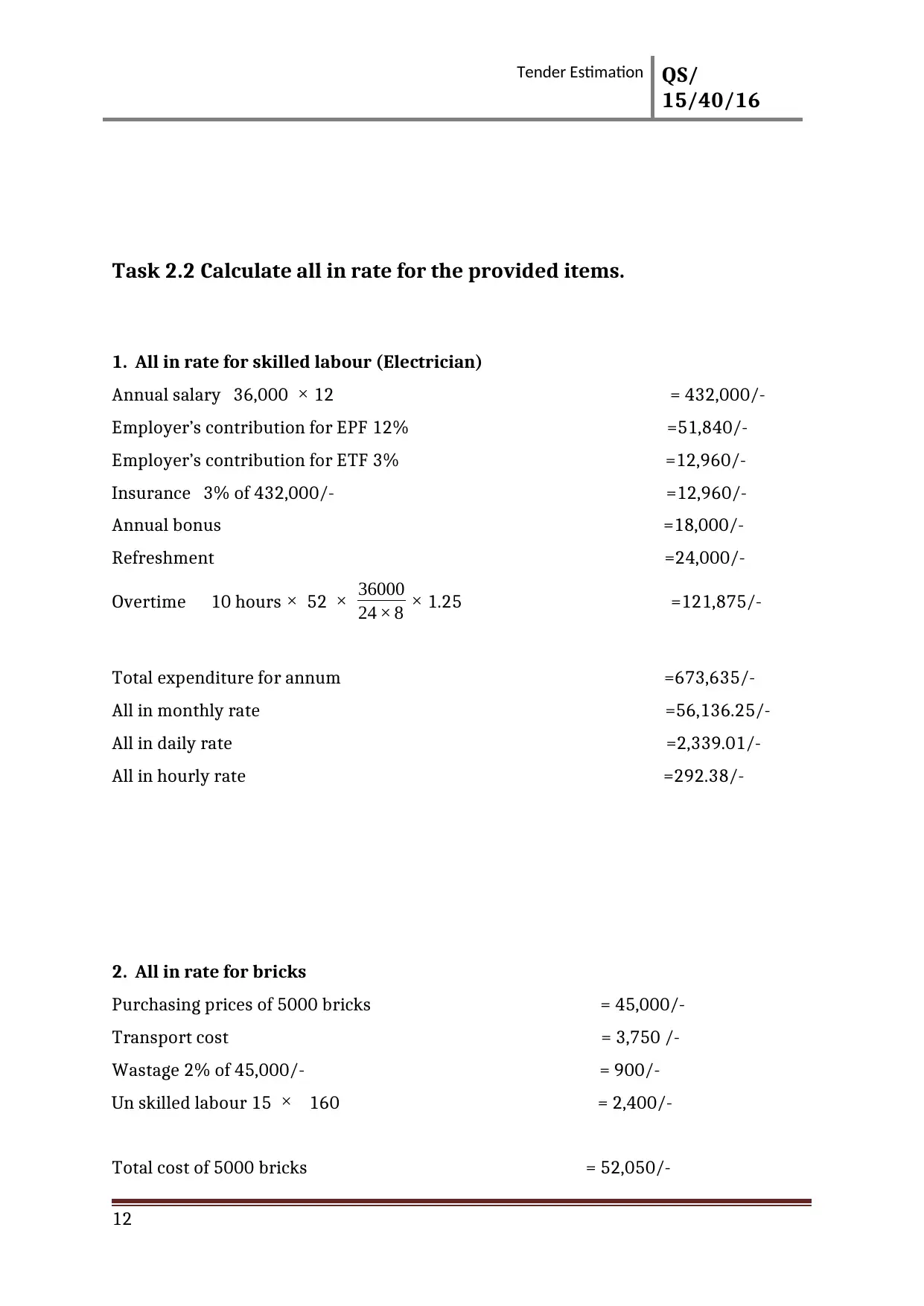
Tender Estimation QS/
15/40/16
Task 2.2 Calculate all in rate for the provided items.
1. All in rate for skilled labour (Electrician)
Annual salary 36,000 × 12 = 432,000/-
Employer’s contribution for EPF 12% =51,840/-
Employer’s contribution for ETF 3% =12,960/-
Insurance 3% of 432,000/- =12,960/-
Annual bonus =18,000/-
Refreshment =24,000/-
Overtime 10 hours × 52 × 36000
24 × 8 × 1.25 =121,875/-
Total expenditure for annum =673,635/-
All in monthly rate =56,136.25/-
All in daily rate =2,339.01/-
All in hourly rate =292.38/-
2. All in rate for bricks
Purchasing prices of 5000 bricks = 45,000/-
Transport cost = 3,750 /-
Wastage 2% of 45,000/- = 900/-
Un skilled labour 15 × 160 = 2,400/-
Total cost of 5000 bricks = 52,050/-
12
15/40/16
Task 2.2 Calculate all in rate for the provided items.
1. All in rate for skilled labour (Electrician)
Annual salary 36,000 × 12 = 432,000/-
Employer’s contribution for EPF 12% =51,840/-
Employer’s contribution for ETF 3% =12,960/-
Insurance 3% of 432,000/- =12,960/-
Annual bonus =18,000/-
Refreshment =24,000/-
Overtime 10 hours × 52 × 36000
24 × 8 × 1.25 =121,875/-
Total expenditure for annum =673,635/-
All in monthly rate =56,136.25/-
All in daily rate =2,339.01/-
All in hourly rate =292.38/-
2. All in rate for bricks
Purchasing prices of 5000 bricks = 45,000/-
Transport cost = 3,750 /-
Wastage 2% of 45,000/- = 900/-
Un skilled labour 15 × 160 = 2,400/-
Total cost of 5000 bricks = 52,050/-
12
⊘ This is a preview!⊘
Do you want full access?
Subscribe today to unlock all pages.

Trusted by 1+ million students worldwide
1 out of 28
Related Documents
Your All-in-One AI-Powered Toolkit for Academic Success.
+13062052269
info@desklib.com
Available 24*7 on WhatsApp / Email
![[object Object]](/_next/static/media/star-bottom.7253800d.svg)
Unlock your academic potential
Copyright © 2020–2025 A2Z Services. All Rights Reserved. Developed and managed by ZUCOL.





